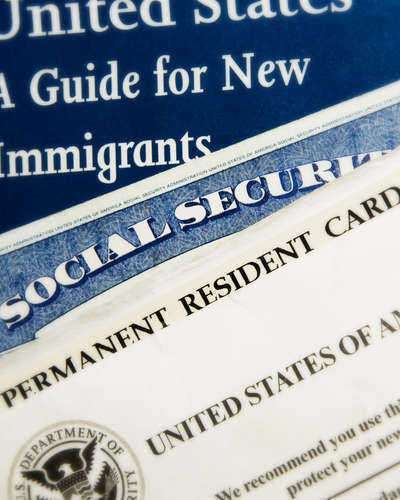
Green Cards and Preference Based Eligibility: The Complete Guide
A Green Card, also known as a Permanent Resident Card, is a document issued by the U.S. government that allows individuals to permanently live and work in the United States. Green cards are highly sought-after, and the eligibility criteria for obtaining one is complex and based on a preference system. In this comprehensive guide, we’ll explore everything you need to know about Green Cards and preference-based eligibility.
What is a Green Card?
A Green Card is a legal document that gives non-citizens the right to live and work permanently in the United States. The name “”Green Card”” comes from the color of the card, which for many years had a green hue, although the card has since changed to a more secure, tamper-resistant design that no longer resembles a traditional card.
Green Cards are issued to individuals who meet certain eligibility criteria and who intend to permanently reside in the U.S. Eligible individuals are typically sponsored by a U.S. citizen or permanent resident, or they may be eligible based on certain qualifying criteria.
There are several ways to obtain a Green Card, including family sponsorship, employment-based sponsorship, or diversity visa lottery. However, the eligibility criteria for each method differ and are based on a preference system.
What are the eligibility criteria for a Green Card?
The eligibility criteria for a Green Card are complex, and they depend on the preference system that governs the visa category. There are several categories of Green Card preferences, with each based on the immigrant’s relationship to the sponsor or the individual’s employment eligibility.
Family-Based Sponsorship
U.S. citizens and permanent residents can sponsor certain family members for Green Cards. The eligible family members include spouses, unmarried children under 21 years of age, parents, and siblings.
Employment-Based Sponsorship
Individuals who are eligible for employment-based sponsorship include those who are skilled workers, professionals, or who have the necessary education and experience to qualify for certain jobs within the United States. In addition, individuals who have extraordinary ability in their field of work, as well as certain immigrants who wish to invest capital in the U.S., are also eligible for employment-based sponsorship.
Diversity Visa Lottery
The Diversity Visa Lottery allows individuals from countries with historically low immigration rates to apply for a Green Card. To be eligible for the Diversity Visa Lottery, individuals must have a high school diploma or equivalent or at least two years of work experience within the last five years in a profession that requires at least two years of training or experience.
Preference System
The Green Card preference system prioritizes immigrants based on their relationship to the sponsor or their employment eligibility. The preference system is designed to give preference to spouses, minor children, and parents for permanent residency.
First Preference (EB-1): Individuals who have extraordinary ability in the sciences, arts, education, business, or athletics, and are considered exceptional in their field.
Second Preference (EB-2): Individuals who are professionals with an advanced degree, or individuals with exceptional ability in the sciences, arts, or business. Also, individuals who are national interest waivers of the labor certification requirement.
Third Preference (EB-3): Skilled workers, professionals, and other workers. Skilled workers are those who have at least two years of job experience or training and are not seasonal or temporary workers. Professionals are those whose jobs require at least a bachelor’s degree from a U.S. university or college or its foreign equivalent. Other workers are those who don’t meet the definition of skilled workers or professionals, including unskilled or low-skilled workers.
Fourth Preference (EB-4): Special immigrants, including religious workers, certain Iraqi and Afghan translators, and others.
Fifth Preference (EB-5): Immigrant investors who invest in new commercial enterprises that create jobs in the U.S.
How to apply for a Green Card?
The application process to obtain a Green Card is lengthy and requires several steps, including the submission of various documents and forms. The application process varies depending on the category of eligibility. Below is a general outline of the steps required to obtain a Green Card.
Step 1: Obtain Initial Sponsorship
The first step to obtaining a Green Card is to obtain sponsorship from a U.S. citizen or permanent resident, depending on the preference category. Once the sponsor has agreed to sponsor the immigrant, they must file a petition on behalf of the immigrant with the U.S. Citizenship and Immigration Services (USCIS).
Step 2: Wait for Approval of Petition
Once the petition is filed, the USCIS will review the application to determine if the immigrant meets the eligibility criteria for the particular preference category. If the petition is approved, the immigrant will receive a priority date, which is used to determine when the immigrant can apply for a Green Card.
Step 3: Apply for a Green Card
After the immigrant’s priority date becomes current, they can apply for a Green Card through either adjustment of status or consular processing. Adjustment of Status is the process of obtaining a U.S. Green Card while staying in the country. Consular Processing is the process of obtaining a U.S. Green Card while outside of the country, typically when living abroad.
Step 4: Attend Immigration Interview
Before the Green Card is granted, the applicant will attend an interview with the USCIS or the U.S. embassy or consulate. During the interview, officials will ask about the individual’s background and intentions while in the United States.
Step 5: Receive Green Card
If the immigrant’s application is approved, they will receive the Green Card shortly afterward.
What are the benefits of having a Green Card?
Holding a Green Card has several benefits for immigrants, including the right to live and work permanently in the United States. In addition, Green Card holders can travel outside the country for extended periods without losing their status, can sponsor certain family members for immigration, and are eligible for certain federal benefits such as social security and Medicare.
However, holding a Green Card also comes with certain responsibilities. Green Card holders are required to report any change in their address to the USCIS, maintain a permanent residence in the U.S., and obey all U.S. laws.
Conclusion
In conclusion, obtaining a Green Card is a complex and detailed process that requires careful consideration and preparation. To be eligible for the Green Card, applicants must meet specific immigrant categories such as family-based sponsorship, employment-based sponsorship, or the Diversity Visa Lottery. Once an individual is eligible, they must file a petition and wait for USCIS approval. Finally, they must attend an immigration interview to receive their Green Card. Green Card holders enjoy several benefits, including the right to live and work permanently in the United States and the ability to sponsor their family members for immigration.
To apply for a green card to the United States, for the sake of an analogy, is sort of like trying to find a table at a crowded restaurant with more people in the restaurant than the tables and chairs can accommodate. While the order in which a party puts a name on the waiting list has an impact on when they get called, different parties will have different odds of being the next one called, as bigger parties will only be able to fit at bigger tables, while couples can fit at tables small and large.
While size may not be an issue when it comes to those who apply for a green card, the time needed for green card processing may be dependent on the individual and their profession. Two of the most common ways people apply for a green card are through family and work. Not all family and work visas are made equal, however. In fact, some may experience longer green card processing times based on a priority system built into these categories.
Regarding those who apply for a green card based on a connection through family, there is a definite pecking order. For spouses, parents, and unmarried children under 21, there are an unlimited amount of visas available to be secured prior to obtaining a green card. For all other categories, though, there are yearly quotas attached and a tiered preference system, meaning these relatives will be subject to the rigors of the green card processing system. There are four tiers for the family-oriented green card system after spouses of U.S. citizens, parents and unmarried children under 21.
First priority is given to unmarried children of U.S. citizens above the age of 21. Following them are spouses of a permanent resident and (note that someone with a green card who is a permanent resident is not the same thing as a citizen) those unmarried children who are over 21 years of age. Rounding out the category are the married children of U.S. citizens and their families, and last but unfortunately least in order of preference, brothers and sisters of citizens. Green card processing for this last category may take upwards of a decade to complete.
Regarding those who apply for a green card in order to serve our country through work, there is also a totem pole of sorts. Here, distinctions are not made based on the closeness of familial connections or age, but on the type of service these immigrants may provide. Green card processing is kindest first to those who possess an extraordinary talent, ability, depth of knowledge or prestige.
After that, different skills are taken into account, and you can probably guess what the different groups would be. The second group earns their preference on the basis of an advanced degree or other special talent. After that, preference is afforded to skilled workers, then special classes of workers and finally workers whose toils will result in job creation for others.






























